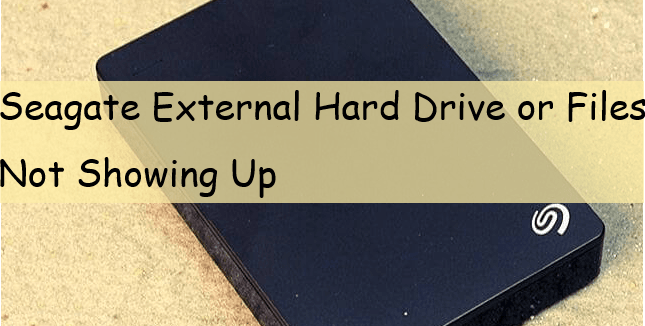Seagate external hard drive files not showing up? Here, you can learn how to recover deleted files from Seagate external hard drive. In addition, some useful tips are provided to make the external hard drive visible again when it is not showing up.

Occasionally, when you plug in a Seagate external hard drive and try to access it, but find your files are not showing up. Worse yet, the Seagate external hard drive is not showing up. You will then want to know:
All of them are included in this article. You can get them now below.

Varieties of reasons can cause the Seagate external hard drive files not showing up issue. Also, you may encounter files disappeared from external hard drive, such as Samsung, Western Digital, SanDisk, etc. We collect some common reasons below.
IMPORTANT: If the Seagate external hard drive not showing up, you’d better not write new data to it. Any new data will overwrite the files not showing up on your external disk, especially if you are sure the files are not hidden.
Don’t worry, we will show you several methods to fix the Seagate external hard drive disappearance issue. You can start with the first method to show hidden files if you are not sure whether your files are hidden or not.
Please refer to the following steps to unhide hidden files using Windows File Explorer. If you’re proficient in PCs, you can also use the attrib command to recover hidden files from USB drives.
Step 1. Connect the Seagate external hard drive to your PC. Then open Windows File Explorer by pressing the “Win + E” keys.
Step 2. Click your connected Seagate external hard drive. Then click “View” > “Options”.
Step 3. Under the View tab, select the “Show hidden files, folder, and drives” option. Please remember to click “Apply” > “OK”.
Sometimes, the corrupted/damaged file system could lead you can’t see files on Seagate external hard drive. In this scenario, if the Seagate external hard drive files not showing up, these steps can help you check and fix your Seagate external hard drive’s file system error.
Step 1. Connect your Seagate external hard drive to the computer. Go to “This PC” > right-click on this connected drive > “Properties.”
Step 2. Click “Tools” > “Check” to begin the error-checking process.
Step 3. Check“Scan drive” to fix the error that you can’t see files on Seagate external hard drive.
If the virus infection has discouraged you from changing the file attribute, you can reset the registry value to fix the Seagate external hard drive files disappeared.
Step 1. Press “Win + R” and type “Regedit” in the Run command window. Then hit “Enter” or press “OK” to open it. Go to this path:
HKEY_LOCAL_MACHINE\SOFTWARE\Microsoft\Windows\CurrentVersion\Explorer\Advanced\Folder\Hidden\SHOWALL
Step 2. Double-click the “CheckedValue” registry key and change its value to “1”.
If you still can’t see files on Seagate external hard drive, they are likely to be deleted or lost due to unknown reasons. In this case, the best way is to use data recovery software like AOMEI FastRecovery.
It supports two advanced scanning methods - Quick Scan and Deep Scan that can find all the deleted or lost files on Seagate external disk or other disk brands, such as Western Digital, SanDisk, Samsung, etc.
Now download Windows data recovery software and install it on your computer. Then follow the steps below to solve your issue of Seagate external hard drive files disappearing.
Step 1. Connect the Seagate external hard drive to the computer and launch the software. Then, find your Seagate external hard drive and click Scan.
Step 2. It will scan the drive with Quick Scan. In addition, you can use the Filter and Search to narrow the scanned scope to quickly find the files. If the target file is still not found, click Deep Scan to search for more disappearing files on the external hard drive.
Step 3. Select all the deleted or missing files on Seagate external hard drive. Then, click “Recover” and save these restored files in a new location. Saving files in the original location may cause data corruption or further data loss.
Some users also report that the Seagate external hard drive is not showing up. This may be caused by loose or faulty USB ports and cables, corrupted disks, unsupported file systems, outdated drivers, virus attacks, etc. Anyway, we have collected some useful methods to fix this issue below.
Here are some basic troubleshooting you can try before other advanced methods.
It’s impossible to view the unlettered drive with Windows File Explorer. If you want to make it visible, please assign a new drive letter.
Step 1. Connect your external hard drive to the computer. Press “Win + R” and type “diskmgmt.msc” in the Run command window. Then hit “Enter” to open the Disk Management.
Step 2. Right-click on your external hard drive, then click “Change Drive Letter and Paths” > “Change” > “Assign the following drive letter” (The new drive letter is different from all the existing drive letters).
If you haven’t updated disk drivers for a long time or suspect it’s damaged, please update or reinstall them in Device Manager.
Step 1. Connect your Seagate external hard drive and be sure it’s recognized. Press “Win + R” and type “devmgmt.msc” in the Run command window. Then hit “Enter” to open the Device Manager.
Step 2. Expand “Disk drivers”, right-click the Seagate external hard drive, and click “Update driver”.
Step 3. Click “Search automatically for drivers”. It will automatically search available drivers and install them on your device. If you still have problems seeing this drive, click "Uninstall device" in the previous step and restart your computer.
Sometimes your Seagate external hard drive is infected by a virus and becomes invisible. You can use Windows Defender to scan and remove the virus.
Step 1. Go to “Windows Settings” > ”Update & Security” > ”Windows Security” and select “Virus & threat protection”.
Step 2. Click the “Scan options” under Current Threats.
Step 3. Check “Full scan” and click “Scan now” to scan viruses currently on your disk and remove them.
The last resort is to format your Seagate external hard drive and make it reusable. Remember to use a compatible file system. In Windows PC, the most commonly used file systems are NTFS, FAT32/16, exFAT, etc. If there is important data, please recover files from Seagate external hard drive first.
Step 1. Click the “Start” menu and select “Disk Management”. Find out the Seagate external hard drive not showing up in File Explorer.
Step 2. Right-click the disk and select “Format”.
Step 3. In the Format window, select file system- NTFS and click OK. You can also select FAT32, FAT16, exFAT, etc.
Step 4. Click OK again when you see a formatting warning.
For more methods, you can check Seagate external hard drive not working.
Backups are the best hedge against data loss. In this case, you can use free backup software for Windows - AOMEI Backupper Standard to make a “File Backup”. If you cannot see files on Seagate external hard drive, you can restore your needed files from this backup. If you need it, “Disk Backup” is also allowed for you.
Step 1. Download, install, and launch free backup software for Windows - AOMEI Backupper Standard. Choose “Backup” and “File Backup” subsequently.
Step 2. Type a new task name to distinguish it from other backup tasks. Click “Add File” or “Add Folder” to select files or folders on your Seagate external hard drive.
Step 3. Click the second box and select a local path, share NAS, or another cloud drive to save another copy of your important files.
Step 4. To backup Seagate external hard drive files automatically, click “Schedule Backup” and enable the “Daily”, “Weekly”, “Monthly”, “Event trigger”, or “USB plug in” options.
Step 5. Confirm all the configured backup settings and click “Start Backup” to backup your files or folder on Seagate external hard drive. It will create a full backup first and then backup only changed files at the scheduled backup time.